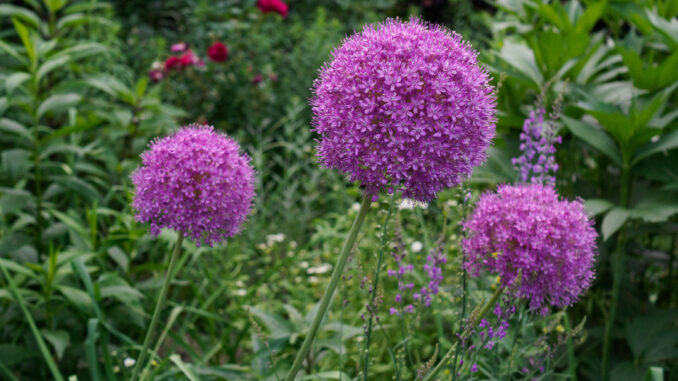
If you want to return from a winter journey to a garden full of spring bloom, you’d best get busy in autumn. Despite the flurries soon to fall, there’s still time to get spring-blooming bulbs into the ground. And, while you’re at it, grab back those bags of leaves and use them to blanket bare soil.
The weeks of October through to early December are planting times for spring-blooming bulbs and they can be set into soil right up to frost, and even beyond. If necessary, you can dig into lightly frozen soil and find soft areas beneath for last-minute bulb planting. All types of spring-flowering bulbs require a chilling period of 12 to 16 weeks at a soil temperature below 4C (40F) before setting down roots and initiating growing tips in early spring. Just get them planted by early December and let them chill underground through the coldest weeks of winter.
This could be the year to consider something unusual – ornamental onions, members of the allium family and distantly related to culinary onions (but entirely without the characteristic scent). Ornamental onions are sometimes called drumstick flowers because of their thick stems topped with round heads. They produce beautiful flowers blooming alongside late spring and early summer perennials, extending the spring bulb display for several weeks.
The flowers of ornamental onions are round spheres of packed florets, exploding in starburst displays of vivid blue, reddish violet, purple, pink, yellow and white. Stem heights and size of flower heads range from short and small selections such as bright yellow Allium Moly Luteum (10 inches) for filling in spaces between rocks, to the commanding height of Allium ‘Summer Drummer’ (four to six feet) with huge globes of eight-inch, purple-and-white florets. Just one of the larger allium bulbs makes a strong focal point, with an emphatic impact in a group of three.
One unusual exception to the round flower form is Allium bulgaricum, a stunningly beautiful flower with a tall stem (36 inches) and purple-and-white flowers that open, spread and dangle like exotic ornaments. It is the latest of the ornamental onions to bloom – appearing in early summer – and never fails to draw attention. Ornamental onions stand in bloom for about three weeks and their bulbs are similarly long-lasting. Just a few clumps are good companions to expanding hosta leaves or paired with rose buds soon coming into bloom.
Leaves are garden gold
Wherever you live, your current address was probably a forested area 300 years ago. Trees grew and dropped their leaves in autumn and the leaves slowly composted on the forest floor, releasing nutrients into the soil. Tree roots absorbed these nutrients and used them to manufacture the next season of leaves. This cycle of growth and renewal can work in gardens where leaves are gathered and allowed to remain as a blanket over tree roots. Instead of cultivating grass lawn right up to tree trunks, consider removing grass from under tree canopies and allowing leaves to remain over the roots where they belong.
Leaves can feed more than the trees from which they fall. Leaves contain all of the nutrients essential for plant life, including nitrogen, phosphorus, potassium, calcium, magnesium, sulfur, zinc, iron and much more. Their fibrous content greatly enriches soil texture, enhancing adequate drainage and fertility. It’s not necessary to bother digging leaves into soil, although that is an admirable effort. Simply sweeping leaves onto garden beds, covering bare soil surrounding hedges, shrubs and perennial plants will reap long-term rewards. Soil fertility will be enriched, essential soil micro-organisms will increase, and the addition of leaf fibre will make nutrients more accessible to plant roots. A blanket of leaves over bare soil also helps to suppress weed growth, prevent excessive evaporation of soil moisture and maintain cooler temperatures in the root zone.
Leaves don’t need to be chopped or shredded into small pieces to be useful. Birch, silver maple, English oak, locust, ginkgo, dogwood, crabapple and lilac leaves are small enough to be used for a blanketing mulch as soon as available. If the weather is dry and fallen leaves are crispy, running a lawn mower over them will easily chop them into small pieces, although this is unnecessary. (Fine pieces of shredded leaves are an excellent soil conditioner for lawns.) Large leaves such as Norway maple and full-size oak could benefit from a pass through the lawn mower, but they can be used whole in a thinner blanketing of approximately one- to two-inch depth. Be sure to include any coniferous needles available from pine, cedar and spruce – they are effective in opening pathways for oxygen to enter the soil. Contrary to common assumption, conifer needles will not contribute excessive acid to the soil environment.
After laying down a two- to four-inch-thick mulch of leaves over bare soil, use a garden hose to thoroughly wet the leaf blanket (or let rain do the job). After drying, this initial shower will help leaves to remain in place and prevent them from blowing around. Although the mulch will appear quite thick and fluffy, at winter’s end, the leaf blanket will shrink down by about a third. If you have too many leaves for immediate use, sweep them into a pile someplace convenient, and let them rest there uncovered through winter. In spring, the leaf pile will have noticeably lowered, the leaves will be softened and partially degraded and you can use them as a source of soil enrichment when planting all through the following summer. Leaves left in an uncovered pile will require two winters to degrade into a luxurious form of leaf mulch, one of the most valuable additions to soil.


